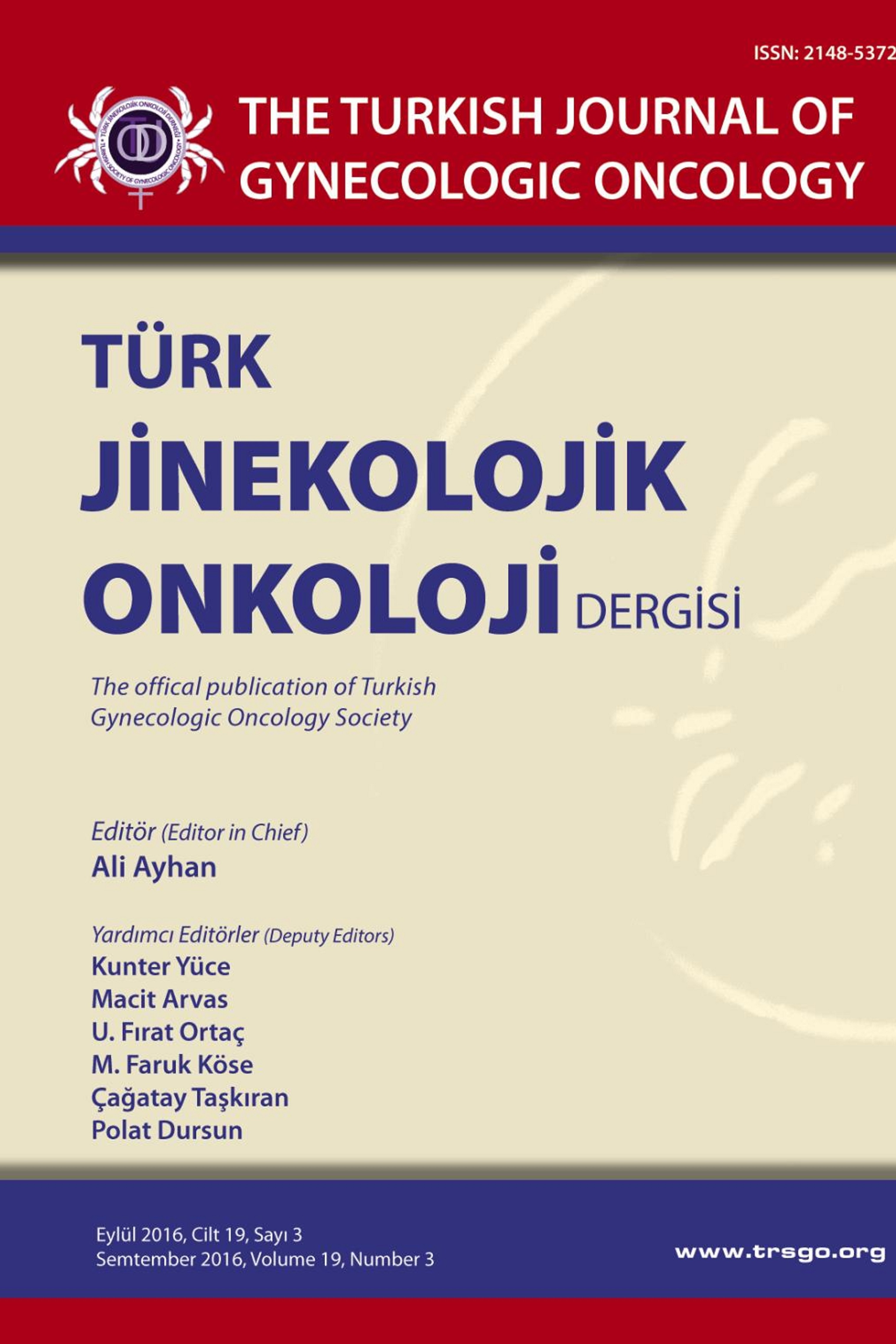2012 YILINDA DÜZCE KETEM’E BAŞVURAN KADINLARDA KOLPOSKOPİ SONUÇLARI VE İLİŞKİLİ FAKTÖRLER
Servikal kanser, Smear, Kolposkopi
THE RESULTS OF COLPOSCOPY AND RELATED FACTORS IN THE WOMEN APPLIED DUZCE KETEM IN 2012
Cervical cancer, Smear, Colposcopy,
___
- 1. Ferlay J. Shin HR, Bray F, et al. GLOBOCAN 2008 vl.2, Cancer incidence and Mortality Worldwide: IARC CancerBase No. Lyon, France: International Agency for Research on Cancer; 2010. Accessed January 23, 2012.
- 2. Gustafsson L, Ponten J, Bergstrom R, adami HO. International incidence rates of invasive cervical before cytologic screening. Int J Cancer. 1997;71:159-165.
- 3. Gustafsson L, Ponten J, Zack M, Adami HO. International incidence rates of invasive cervical cancer after introduction of cytological screening. Cancer Causes Control. 1997;8:755-763.
- 4. Parkin DM, Bray F. Chapter 2: The burden of HPV related cancers. Vaccine. 2006;24(suppl 3): S3/11-25.
- 5. Siegel R, Naishadham D, Jemal A. Cancer statistics,2012. CA Cancer J Clin. 2012;62:10-29.
- 6. American Cancer Society: Cancer Facts&Figures 2012. Atlanta, GA. American Cancer Society.
- 7. Baak JP, Kruse AJ, Robboy SJ, et al. (2006) Dynamic behavioural interpretation of cervical intraepithelial neoplasia with molecular biomarkers. J Clin Pathol 59: 1017-1028.
- 8. Nasiell K, Nasiell M, Vaclavinkova V (1983), Behavior of moderate cervical dysplasia during long-term follow-up. Obstet Gynecol 61:609-614.
- 9. Osttor AG, (1993) Natural history of cervical intraepithelial neoplasia: a critical review. Int J Gynecol Pathol 12 : 186-192.
- 10. Trimble CL, Piantadosi S, Gravitt P, et al. (2005) Spontaneous regression of high grade cervical dysplasia : effects of human papillomavirus type and HLA phenotype. Clin Cancer Res 11:4717-4723.
- 11. McCredie MR, Sharples KJ, Paul C, et al. (2008). Natural history of cervical neoplasia and risk of invasive cancer in women with cervical intraepithelial neoplasia 3: a retrospective cohort study. Lancet Oncol 9: 425-434
- ISSN: 2148-5372
- Başlangıç: 2014
- Yayıncı: Türk Jinekolojik Onkoloji Derneği
KOMPLET MOL VE CANLI FETUSUN BİRLİKTE BULUNDUĞU İKİZ GEBELİK: OLGU SUNUMU
Ali Emre TAHAOĞLU, Deniz BALKAS, Cihan TOĞRUL, Mehmet SATICI, Berrin BALSAK, Tayfun GÜNGÖR
SERTOLİ LEYDİG HÜCRELİ TÜMÖR: 4 OLGU SUNUMU VE LİTERATÜRÜN GÖZDEN GEÇİRİLMESİ
Meryem EKEN, Doğukan ARIĞIN, Ecmel KAYGUSUZ, Mesut POLAT, Ateş KARATEKE
SENKRONİZE ÜÇLÜ PRİMER SERVİKS, ENDOMETRİYUM VE TUBA KANSERİ: OLGU SUNUMU
Abdullah BOZTOSUN, Dinçer SÜMER, Hatice ÖZER, Handan AKER, Ali YANIK
POSTMENOPOZAL DÖNEMDE RASLANTISAL OLARAK SAPTANAN BENİNG DEV BOYUTTA STRUMA OVARİ OLGUSU
Kadir GÜZİN, Sadık ŞAHİN, Abdullah AYDIN, Ahmet GÖÇMEN
SERVİKSİN CAMSI HÜCRELİ KARSİNOMU: NADİR GÖRÜLEN BİR OLGU SUNUMU
Nermin KOÇ, Hülya YAVUZ, Ecmel KAYGUSUZ, Handan ÇETİNER
2012 YILINDA DÜZCE KETEM’E BAŞVURAN KADINLARDA KOLPOSKOPİ SONUÇLARI VE İLİŞKİLİ FAKTÖRLER
Simender MESCİ HAFTACI, Mutlu KALENDER, Ayşe Filiz TEKİN, Suzan DUMAN, Muhsin DEMİRTAŞ
HUMAN PAPİLLOMA VİRÜS AŞILARININ KOMPLİKASYONLARI
Türkan GÜRSU, Güldeniz DESTELİ, Ali AYHAN
NADİR BİR VAKA: JUVENİL GRANÜLOZA HÜCRELİ TÜMÖR
Mehmet YILMAZ, Ünsal İSAOĞLU, İlhan BAHRİ DELİBAŞ, Cemal GÜNDOĞDU
